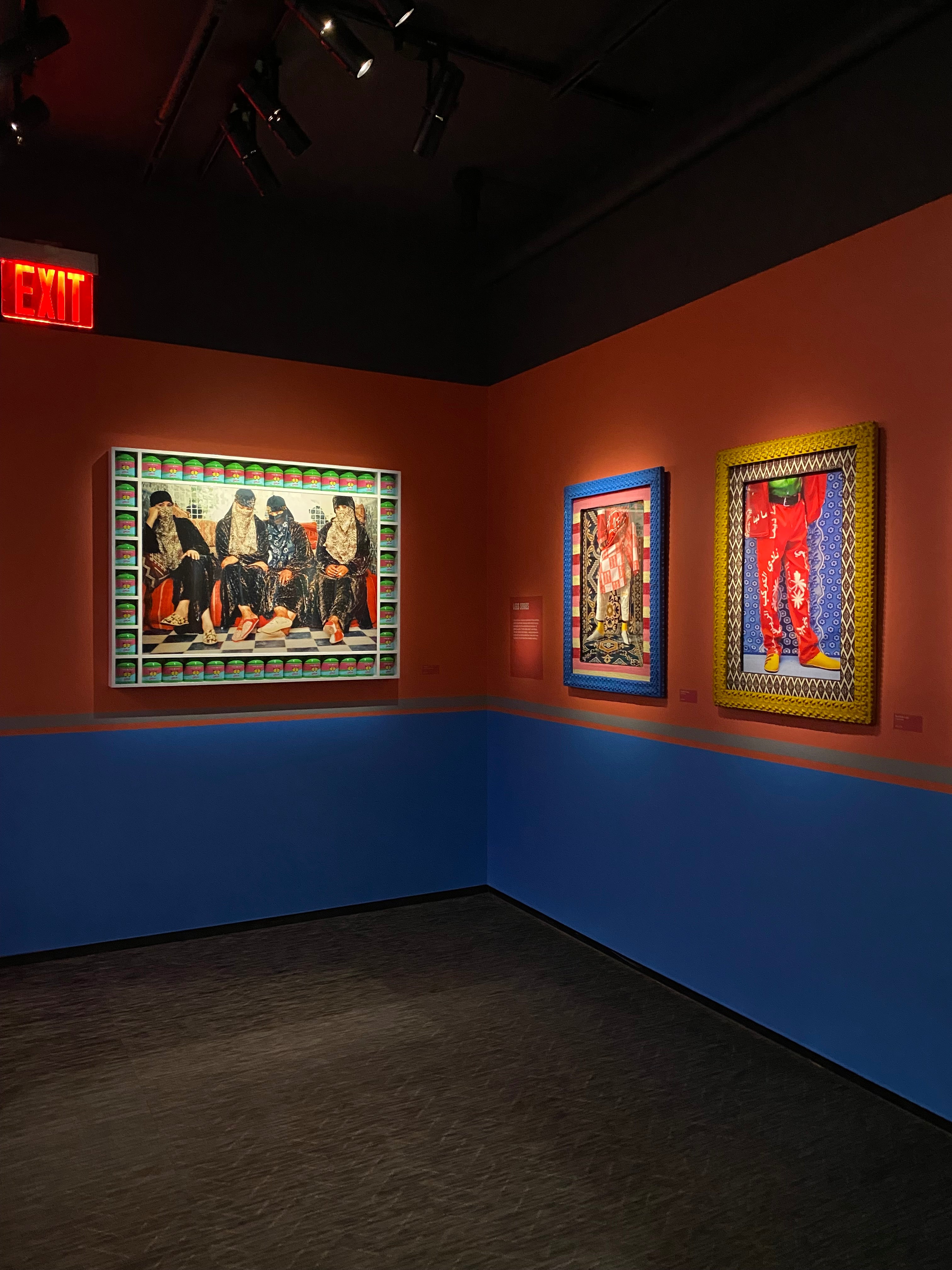 Article written by Yasmine Chokrane
Article written by Yasmine ChokraneWhen I began learning art history, I was always struck by the paradigm that was drawn between Western and Eastern art. And as someone who looks to art to see the human experience “aestheticized”, there was frustration in that—considering my own conflicting cultural identity.
Which is why one of the more memorable artists that I discovered was Yinka Shonibare, the British-Nigerian artist who uses his dual identity as inspiration for many of his pieces. He’s known for his use of Dutch wax fabrics whose turbulent history underscores the instability in cultural composition. Their transience parallels Shonibare’s global presence. He has been featured in world-renowned art institutions like the Tate and the Museum of Modern Art (MOMA). His omnipresence validates the themes within his work: the imperative of globalization, the tether technology creates.
These are questions Hassan Hajjaj asks in “VOGUE, The Arab Issue,” up now at Fotografiska. He is an example of another British-raised artist who is conflicted by his loyalty to another location. Hajjaj was born in the harbor town of Larache, Morocco in 1961, but he and his family immigrated to London when he was 13. Though he was stressed with language learning and finding employment, he took time to explore London’s fashion scene, the street style that encompassed Haute couture and alternative wear. He is self-taught in multiple disciplines, including photography and fashion.

And he weaponizes both in this recent exhibition, where he centers the city of Marrakech in his collection. The caption that accompanies the exhibition title quotes Hajjaj. He laments, ”I sat there and realized all these people were from Europe—stylists, photographers, fashion designers, makeup artists—using Morocco simply as a backdrop, which frustrated me but also made me think. “
I sympathize with the use of Morocco as a backdrop, as someone who has spent much time there and someone familiar with its geopolitics. The legacy of colonization bleeding in from the North through Europe, the pull of Middle Eastern culture from the East, the vibrancy of West Africa deepening the setting from the South, and—most recently— the connection drawn by technology in all directions. In these ways, Morocco's location makes it ripe for discussion—especially in regards to globalization. Hajjaj, a child of that process, recognizes this in the way he merges both cultures and conventions.
For example, he dresses his models in designer branded kaftans and babouches—traditional Moroccan clothes. He plays music that is a mix of synthetic pop, classical arias, and sounds of religious prayer—occasionally littered with conversations in Darija, the Moroccan Arabic dialect. His exhibition immerses the audience in this blend, brushing upon aspects of daily life to paint a larger picture.
Which he does using smaller pictures: photographs of moments, friends stacked atop one another, the illusion of mundanity. A man smoking. Reading a  newspaper. The “Leg Series” better epitomizes the closeness the exhibition displays, portraits of body parts that become the symbol for the “multicultural existence of global nomads,” as the caption describes. The magnification makes these people and moments feel accessible.
newspaper. The “Leg Series” better epitomizes the closeness the exhibition displays, portraits of body parts that become the symbol for the “multicultural existence of global nomads,” as the caption describes. The magnification makes these people and moments feel accessible.
And this is true for many of the people that are photographed: the photos are of people inviting you, but also indifferent to your attention. It demonstrates a type of passive curiosity that comes from being ignored for so long. A man in a tarboosh staring at a sign that reads “Andalous.” A woman standing in front of Arabic text. While others images are evocative: women in niqabs stare directly at the camera, positioned fluidly but their gaze fixed.

This is further asserted by the thematic presence of commercialism. The chairs are crates of Coca-Cola bottles; the portraits are framed by harissa brands. You start to get a sense for why Hajjaj is called the “Andy Warhol of Marrakech.” Both are concerned with similar subject matter. Moroccan products are drawn attention to in vibrant colors that evoke the artists of the Pop Art movement. Artists that, like Warhol, were reactive to the monotony of American consumer culture—one that has now reached all corners of the Earth.
And in this corner, this pocket of reality between Park Ave S and E 22nd Street, Hajjaj gives you a sense for its impact in a country thousands of miles away. He highlights Morocco as this mélange of cultures and their respective influences, the dynamism of global interaction.
More than that, however, he’s able to give you a sense for home. Marrakech is a city too often used as a prop to spotlight Western products, brands, cultures. But in this exhibition, it’s treated with caution in order to give the city space to breathe. By drawing attention to its people, its traditions, its dynamism, the city expands, with the opportunity to invite the audience in.
For people who are unfamiliar, they’re able to momentarily travel, transported to this lively city. But for those of us who are familiar, who have a connection to this country, have spent much time there, it’s a chance to cement a connection that feels so fragile.
For better—or for worse.
QUESTIONS FOR YOU:
- Have you visited institutions like Fotografiska? How has the process of photography democratized art positively?
- What is the importance of artists like Hajjaj and Shonibare in an increasingly globalized economy? In what ways do they herald/caution against the ideals of a globalized world?
- How do you define cultural identity? Does the definition change when considering heterogenous nations? What is the importance of articulating dual identities?
SOURCES:
https://www.tate.org.uk/visit/tate-modern/display/artist-and-society/yinka-shonibare-cbe
https://www.moma.org/artists/24869
https://www.fotografiska.com/sto/en/exhibition/vogue-the-arab-issue/
https://en.vogue.me/culture/interview-hassan-hajjaj/
https://www.moma.org/learn/moma_learning/andy-warhol-campbells-soup-cans-1962/

Hi,
Are you still in business?
I found a few errors on your site.
Would you like me to send over a screenshot of those errors?
Regards
Joe
(714) 908-9255
Hi,
Are you still in business?
I found a few errors on your site.
Would you like me to send over a screenshot of those errors?
Regards
Jacob
(714) 500-7363
Hi,
Are you still in business?
I found a few errors on your site.
Would you like me to send over a screenshot of those errors?
Regards
Jacob
(647) 503 0317
Leave a comment